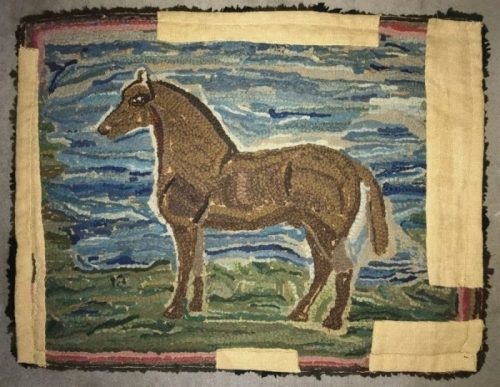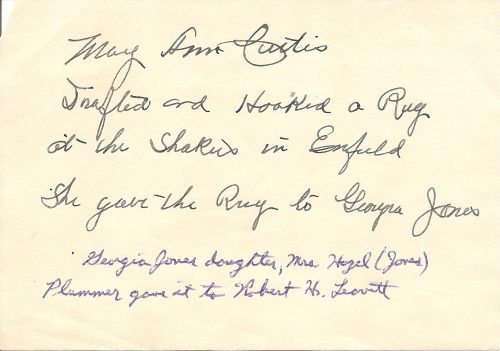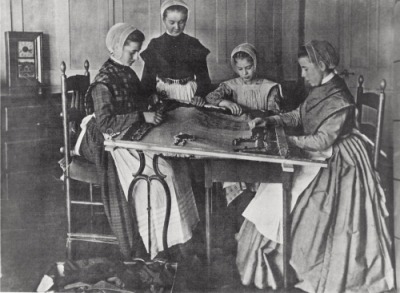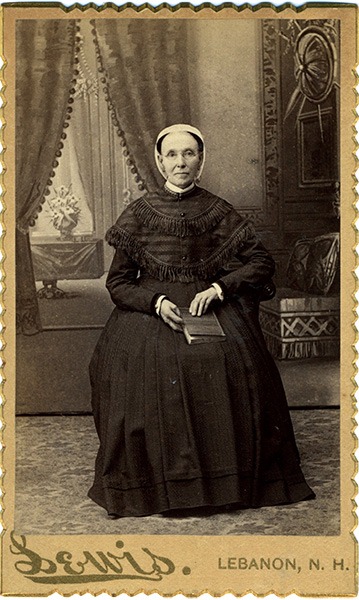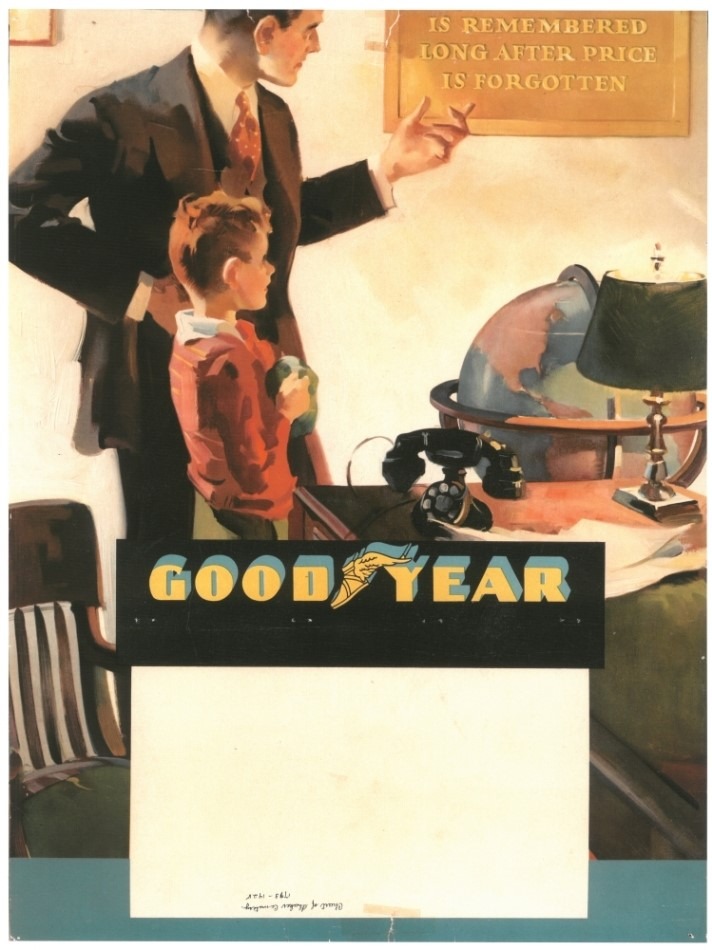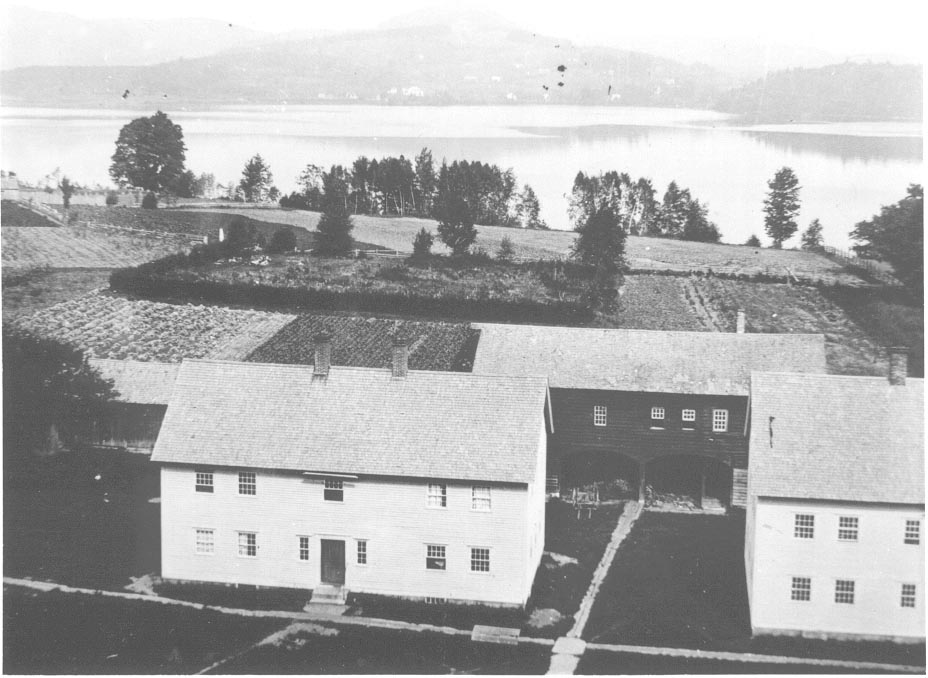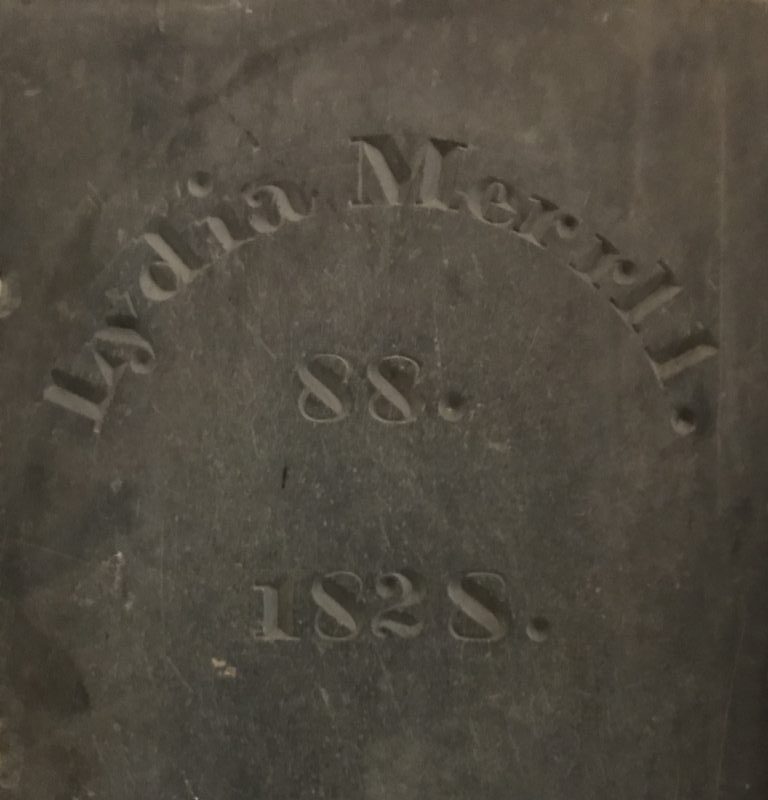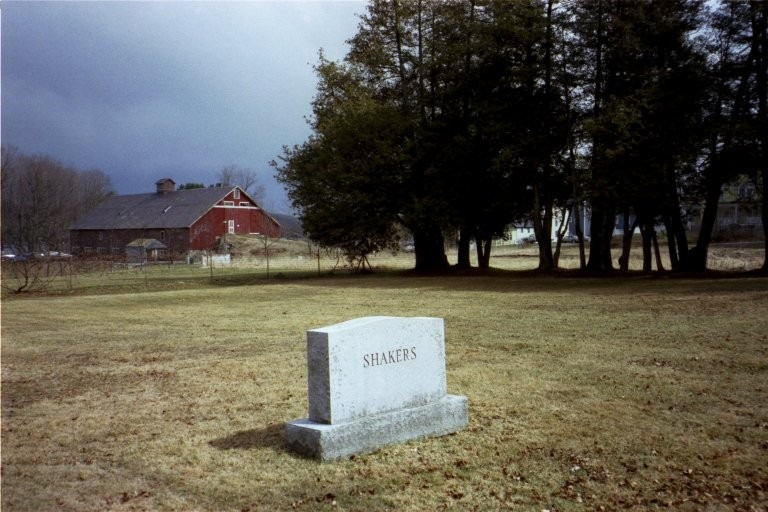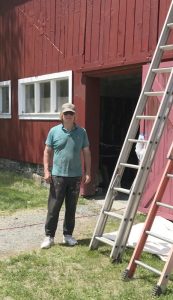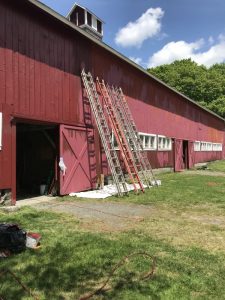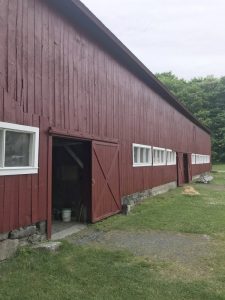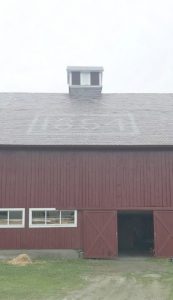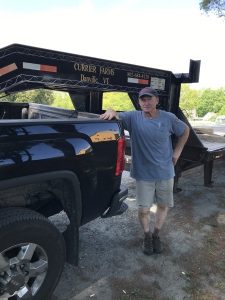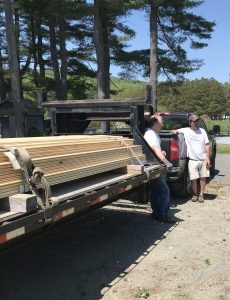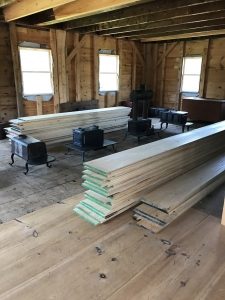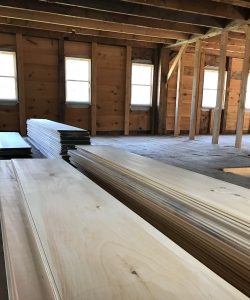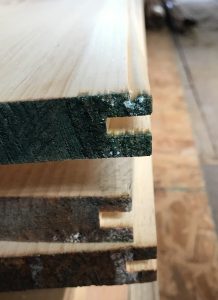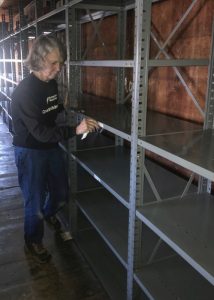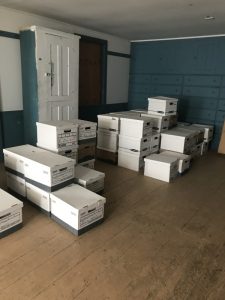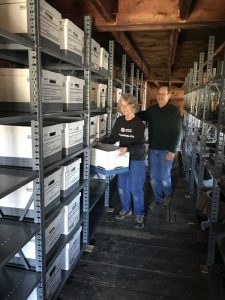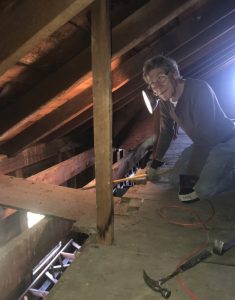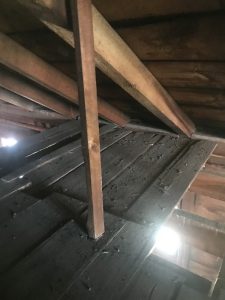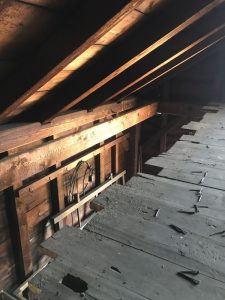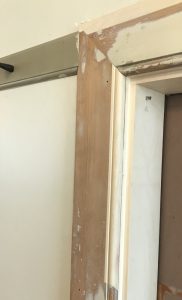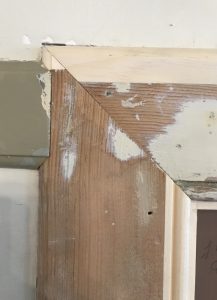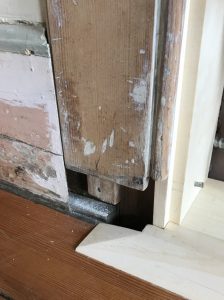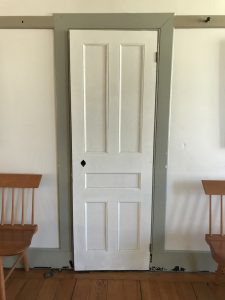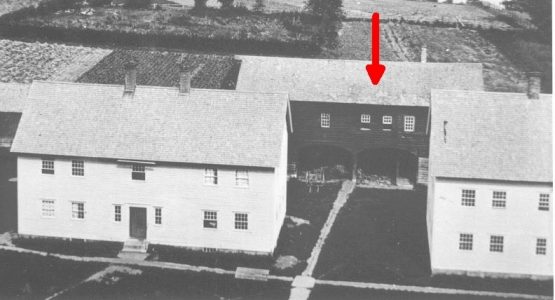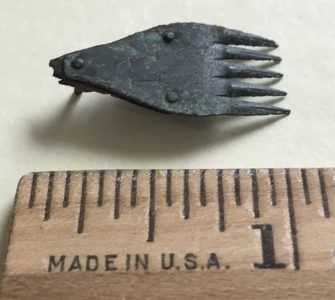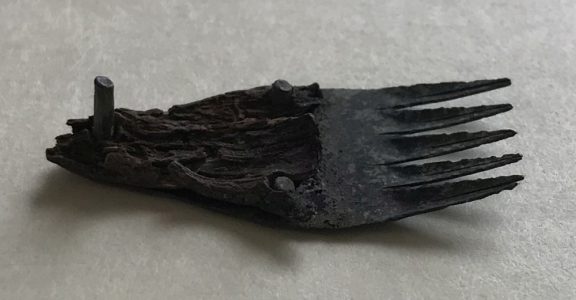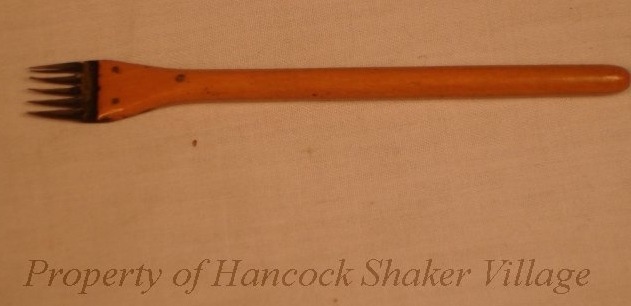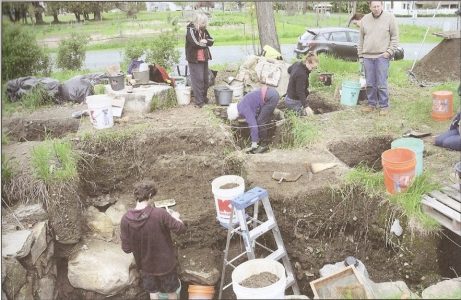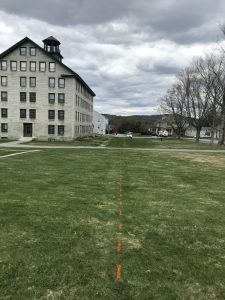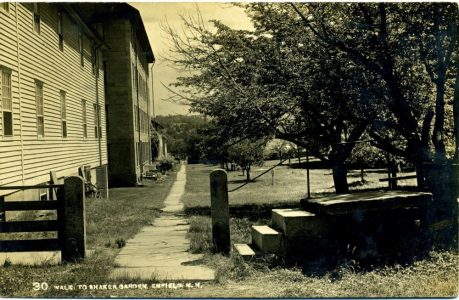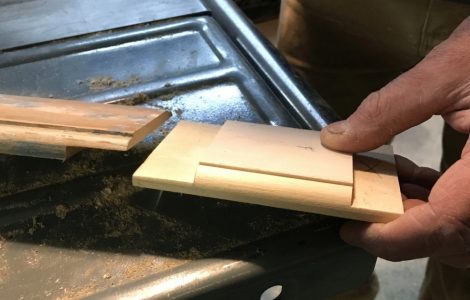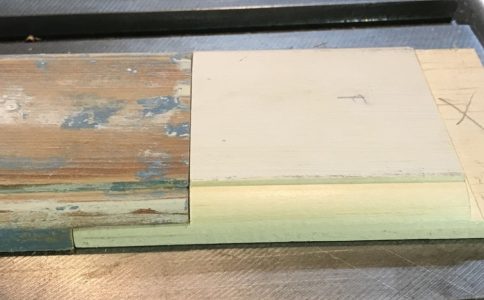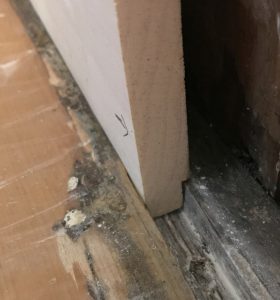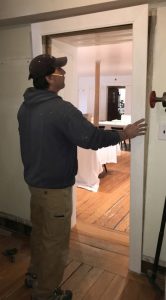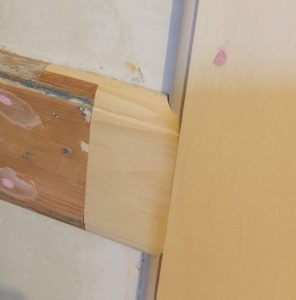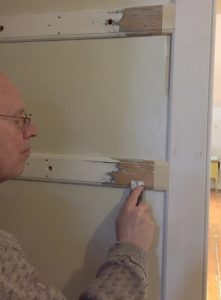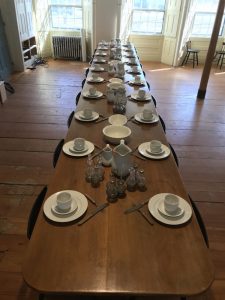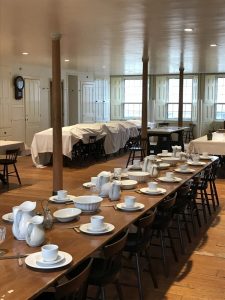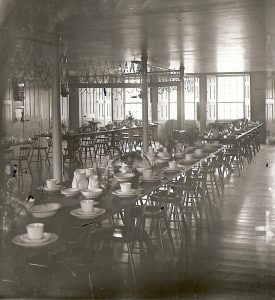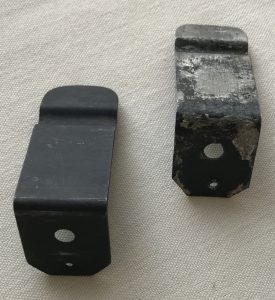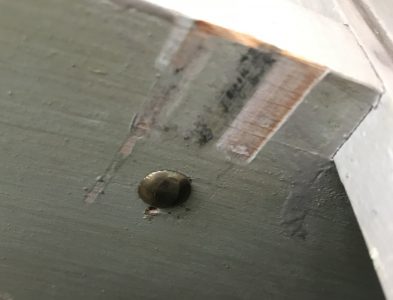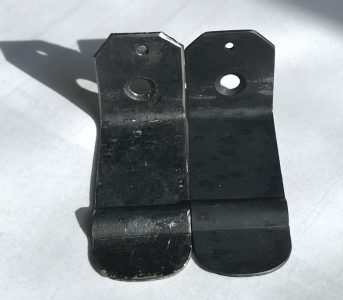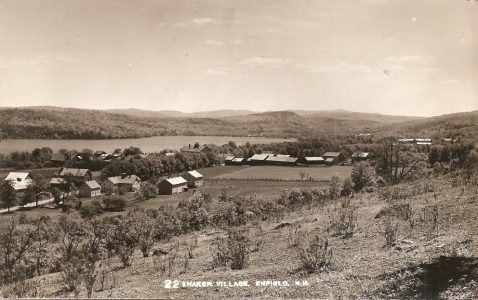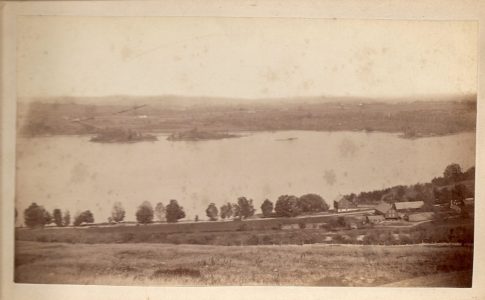Enfield Shaker Museum Collection
Collections Mission:
The Enfield Shaker Museum’s collections help fulfill our primary objectives as a preservation and educational organization. The Museum collects objects made by, used by, or illustrative of the individual and collective lives of the Enfield Shakers, the New Hampshire Bishopric Shaker communities, and Shakerism in general. Objects in our collection range from the most common of everyday objects used by the Shakers, to our largest artifacts–the buildings and the site itself.
[expander_maker id=”1″ more=”Read more” less=”Read less”]Objects in our collection receive care to ensure their survival in perpetuity. Beyond the important work of preserving physical artifacts, we also preserve through our collection the opportunity for future research and education. The body of knowledge of the Shakers is continually expanding, and what we know today will certainly be increased over time.
For our visitors today, artifacts on display create a tangible, visible connection to the Shakers who formerly lived here. Shaker material culture is a fascinating introduction to the history of the individuals who formed this unique communal society in Enfield, New Hampshire.
[/expander_maker]
Curator’s Blog:
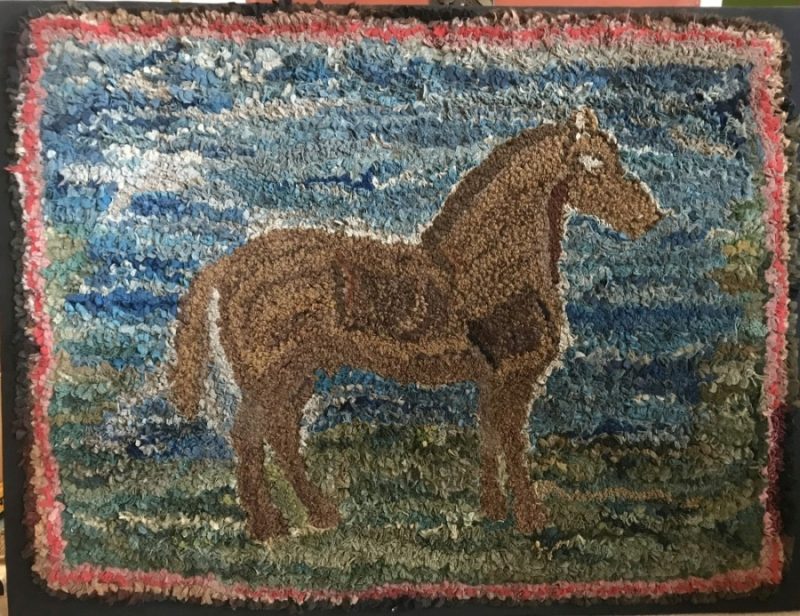
Investigating an Unusual Enfield Rug
October 12, 2021
In 2018 the museum acquired an interesting rug that features a brown horse on a background of green below, depicting grass and trees, and blue above depicting the sky. Around the perimeter are several rows of different colors creating a border.
The subject of a quite realistically depicted horse is unusual in Enfield rugs, which usually have fields of random colors and bold, linear borders. The Shaker Village of Pleasant Hill, Kentucky, has two rugs depicting horses in their collection, so we initially wondered if the rug was received as a gift from Pleasant Hill. Henry Blinn’s account of his trip to Kentucky was searched, but no mention of a rug as a gift was found in his account or any other.
[expander_maker id=”1″ more=”Read more” less=”Read less”]The construction technique is also unusual for an Enfield rug. The horse figure is hooked with yarn on a burlap backing, then the loops on the top surface of the rug are sheared, although many short loops remain uncut. The yarn was hooked in bunches of 4 strands of two-ply yarn, and the spacing of the strands is quite far apart – this gives an interesting texture to the loops that were not sheared. The remainder of the rug – background and border – is a technique called proddy.
Proddy is an old English technique of rug making where pre-cut lengths of fabric are pushed through the backing, typically working from the back of the rug. There is a variation where proddy is worked from the front, but the “shaggy” nature of the front of the rug makes it difficult to do fine detail work from the front. The fabric strips are wider and their spacing further apart in proddy than traditional rug hooking.
Recently, as part of the ongoing cataloging project funded in part by a National Endowment of the Humanities CARES Act grant and a second NEH American Rescue Plan grant, this rug was added to our online collections database. While researching the provenance, or history of ownership, of the rug I learned that it had been owned by Robert H. Leavitt. Mr. Leavitt was the Lebanon town historian and a long-time collector of Shaker objects. In his papers in the museum’s collection, I found a small note in black ink that reads “May Ann Curtis/Drafted and Hooked a Rug/at the Shakers in Enfield/She gave the Rug to Georgia Jones.” Below that in blue ball point pen, in Robert Leavitt’s handwriting is written “Georgia Jones daughter, Mrs. Hazel (Jones) Plummer gave it to Robert H. Leavitt.”
Mary Ann Curtis was born in 1822 and comes to the Shakers with her husband and daughter. The date her arrival is not known, but she was at the North Family in 1843. She spent some time at the North and Church Families but was a member of the Second Family most of her time in Enfield. She died in 1898 and is buried at the Second Family cemetery. The only know prior evidence of her textile related work is the 1870 US Census when she is 48 and listed as a milliner at the Church Family.
Not only do we not have further information about Mary Ann Curtis and rug hooking, there is not much information about rug hooking at Enfield in general, and we don’t know of any other Enfield hooked rugs. The only other evidence of rug hooking here is a photo, taken ca. 1903-1911 of young women working on a hooked rug.
To be able to associate an individual Enfield Shaker with an artifact, especially a rug as unique as this one, is highly desirable, but we must approach any conclusions with caution. While Mr. Leavitt clearly had this note and at least one Shaker rug in his possession, it is possible that he had other rugs as well, and unfortunately the note does not definitively describe the rug. It is our hope that more information can be gathered allowing us to definitively prove who made it and document its path through time until it arrived back here at Enfield Shaker Village where it began.
Click here to go to the online catalog records for the rug and the note.
C. E. Lewis, Photographer, Lebanon, NH, ca. 1880
Private Collection.
[/expander_maker]
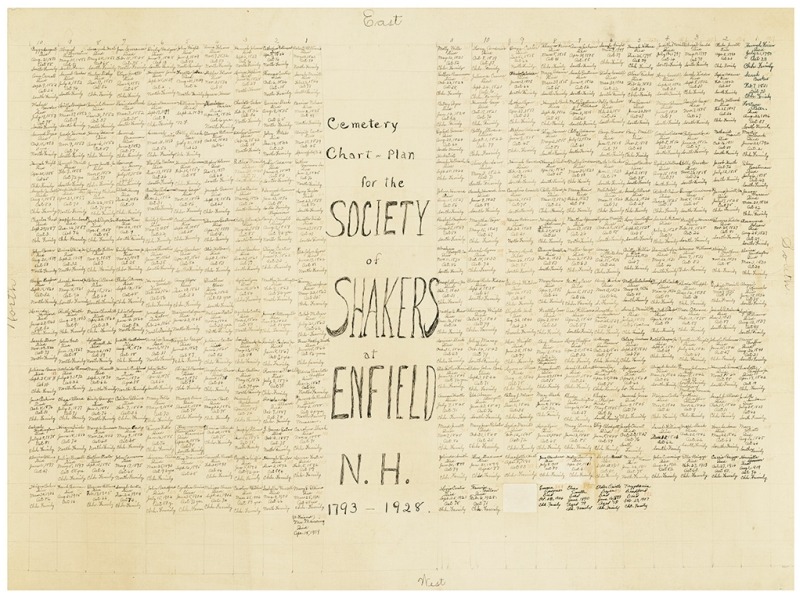
Church Family Cemetery Chart
April 15, 2021
We typically get a steady stream of genealogical requests from researchers interested in more information about their ancestors who were Enfield Shakers. One great information source is a chart in the museum’s collection entitled “Cemetery Chart or Plan for the Society of Shakers at Enfield N.H. 1793-1928.”
[expander_maker id=”1″ more=”Read more” less=”Read less”]Thanks in part to a grant from the NEH to digitize our collections records, this chart is now available via our online collections database at this link: 1993.3.148 – Church Family Cemetery Chart The catalog entry has two linked documents available at the bottom of the record; a higher resolution downloadable photo in which each entry is legible, and a pdf listing all the burials and associated information. The pdf is searchable and the data is exportable if you would like to create a spreadsheet to sort on any of the fields to facilitate data analysis any way that is useful to you. Used together, the pdf and the image will help you find names quickly, without having to visually search the entire chart.
While an invaluable resource, the origins of this chart are uncertain, so if you like a mystery as much as I do, let’s look at the possible who, what, where, when, and why of this chart’s creation.
To understand “when” it may have been drawn, let’s begin with a little background on the final years of the Enfield community. The decision to close the community was made around 1918 and the last Enfield Shakers left for Canterbury in 1923. The remaining land was sold to the La Salette Missionaries in December of 1927, and the last burial in the Shaker cemetery was Sister Fannie Fallon in 1928.
Around this time, with the closure of numerous villages, care of the far-flung cemeteries was becoming overwhelming for the remaining communities. It was decided in many instances to remove the individual head stones and commemorate the entire cemetery with one large stone marked simply “Shakers.”
The year the individual stones were removed at the Enfield Church Family cemetery is not known for certain, but a letter in the collection of Canterbury Shaker Village narrows down the possible date. The letter is from Canterbury Elder Arthur Bruce to George McKenzie Roberts, who was compiling land records, burial records, and vital statistics for Enfield, New Hampshire. Dated October 11, 1933, Elder Bruce states that the individual stones had already been removed, but the new large stone had not been installed. He also states that, “If you feel to give us time, we can supply the following items connected with each burial—name, date of burial and age at death. We make this proposition, as much record material will have to be searched to make the matter complete.”
The prospect of further correspondence between Elder Bruce and George McKenzie Roberts coming to light is intriguing and could further our understanding of the exact date of the removal of the Enfield stones.
We believe the date of creation of the chart is related to the removal of the cemetery stones primarily because no other record of the layout of the plots is known. It seems that the creator either had access to documents that are unknown to us today, or they had access to the stones before they were removed. Our working theory is that the information was gathered, or the chart was begun, while the stones were still standing, possibly to record the location of the burials before or during removal. That would place the creation of the chart after Fanny Fallon’s burial in 1928 (her entry is in the same hand as the rest of the chart, it does not appear to be added after the fact), but before the date of the 1933 letter which states the stones had been already removed.
One other piece of information that may help us date the chart is that it is drawn on the back of a Goodyear Tire advertising calendar. We would love to hear from anyone who can help us date this ad which is pictured at the bottom of this post.
Let’s move on to “who” drew it. The oral history is that the work of removing the stones was done by the La Salettes at the request of the Canterbury Shakers. Much of the information on the chart was available in the cemetery, such as the order of the burial plots, but other information on the chart was not available in the cemetery or on the stones, so there must have been another source of information. The few stones from the Church Family cemetery in the museum’s collection contain three pieces of information: name, year of death, and age. The chart includes that information plus, month and day of death, the Shaker family the deceased belonged to, and in some instances additional information. (For example James G. Russell’s entry states “Musician” and Moses Johnson’s “Builder of meeting houses”)
It seems most likely that Canterbury provided the additional information, but there is no record of visits or correspondence. Journals at Canterbury record many trips to Enfield during this time period, including several for business related to the cemetery, but those all referenced fencing, no mentions of removal of the stones are included. The use of the abbreviation AET – Latin aetatis, of the age – and the fact that the chart remained at Enfield in the possession of the La Salettes may indicate that they created it, possibly answering the “where” question as well.
“What” is a little easier, since we have the chart to examine. The chart measures 20” x 27”and is drawn in ink on the back of a Goodyear Tire advertising calendar. The page is laid out into a grid of squares with 10 columns on the left, 11 columns on the right, and a title block in the middle. Interestingly the columns are numbered right to left on either half. The entire chart seems to be in the same hand except for the last 4 entries at the lower right. There are three squares with paper glued over them as to cover mistakes. The grid cells are numbered in red, which has faded, but is still legible. The cardinal directions are written along the margins of the chart, but there are no specific landmarks, measurements, or any other indication of scale or actual distances. The appearance is generally one of an informal work, but the sheer volume of labor involved in recording this amount of data shows that considerable effort and time was spent on this work.
And last we come to “why.” As mentioned above, it has been our theory that the chart was created to record the locations of the Enfield Church Family cemetery burials as the stones were being removed. We hope that new information will someday come to light to either substantiate this theory or point us in another direction, but one thing is for certain – we are indebted to whoever took the care and time to create this record of the cemetery and to the La Salettes for preserving and caring for it over the years so that this important resource is available to researchers today.
[/expander_maker]
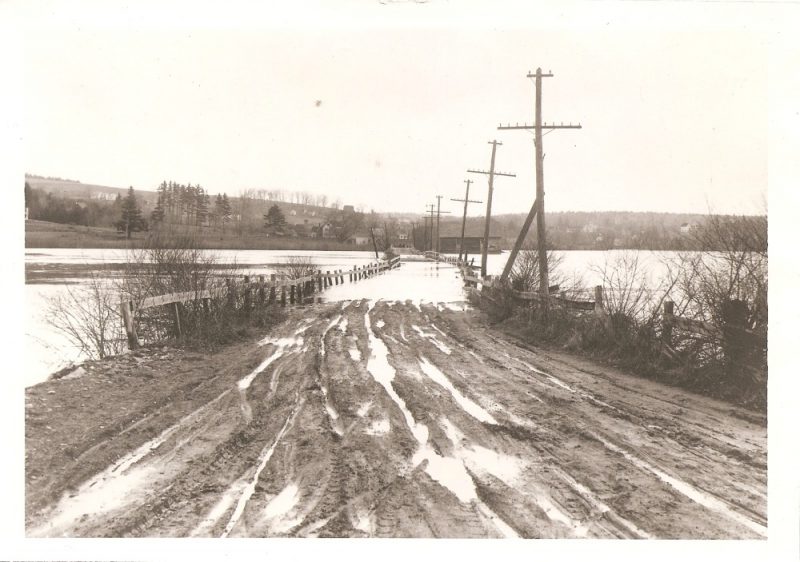
An exciting account of the last person to drive over the Shaker Bridge
March 11, 2021
Our Weather-Wise series continues tonight with a presentation about the Great New England Hurricane of 1938 by Dr. Lourdes Aviles from Plymouth State University. To accompany tonight’s program, I would like to share this paper from our collection about the last person to drive over the Shaker Bridge on September 21, 1938 during the developing storm. Author Margaret Seamans shares the story of her father, Ernest Walter Parker, as he narrates the details of his harrowing journey home that day in his 1929 Model A Roadster.
[expander_maker id=”1″ more=”Read more” less=”Read less”]Here is the link to Ernest Walter Parker’s story, I hope you find it as exciting as I do. 2013.12.1 Shaker bridge article
We are rapidly losing the generation of people who lived through that storm, use this as a reminder to ask a grandparent, aunt, or uncle about their story. I think you will find that virtually no one who lived through that storm in New England will have forgotten that day.
[/expander_maker]
Enfield Shaker Brother Nelson Chase’s Patented Folding Stereoscope
September 24, 2020
Today the museum was delighted to participate in a virtual program hosted by Hancock Shaker Village entitled “Shaker Collections from the Virtual Vault.” The program included presentations by Hancock Shaker Village, Shaker Museum | Mount Lebanon, South Union Shaker Village, and the Enfield Shaker Museum.
[expander_maker id=”1″ more=”Read more” less=”Read less”]Enfield’s presentation highlighted an interesting object from the collection, Enfield Brother Nelson Chase’s patented folding stereoscope. Mildly vexed by technical difficulties during the original program, you can now watch a complete version of this presentation on Youtube.
[/expander_maker]
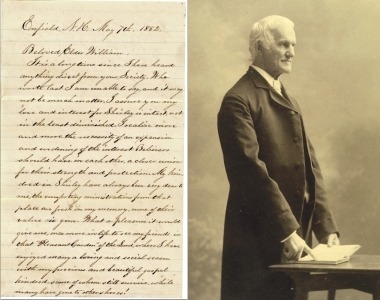
Museum Receives donation of 1882 Letter from the Shirley (MA) Historical Society
September 3, 2020
The two-page letter is written in ink on both sides of a single piece of lined paper in a beautiful hand. The letter begins “Enfield, N.H. May 7th, 1882” and is addressed to “Beloved Elder William,” likely Shirley (MA) Shaker Village Elder William Weatherbee. The letter is not complete so there is no signature, but the writing is believed to be that of Enfield Elder Abraham Perkins.
[expander_maker id=”1″ more=”Read more” less=”Read less”]The letter is a beautiful addition to our collection and constitutes an excellent insight into the life of an Enfield Shaker on that day. If you would like to view the letter, I’m happy to announce that it is now possible to view it online. The museum is in the process of creating an online collections database as part of a NEH grant through the CARES Act, and this letter is included in a small number of artifacts and photos that have been made available as we develop the site. Follow this link to our collections database to see the online object record, photos, a pdf scan of the letter, and a transcription. While you are there, have a look around and let us know what you think, you have the chance to be one of our first Beta testers!
[/expander_maker]
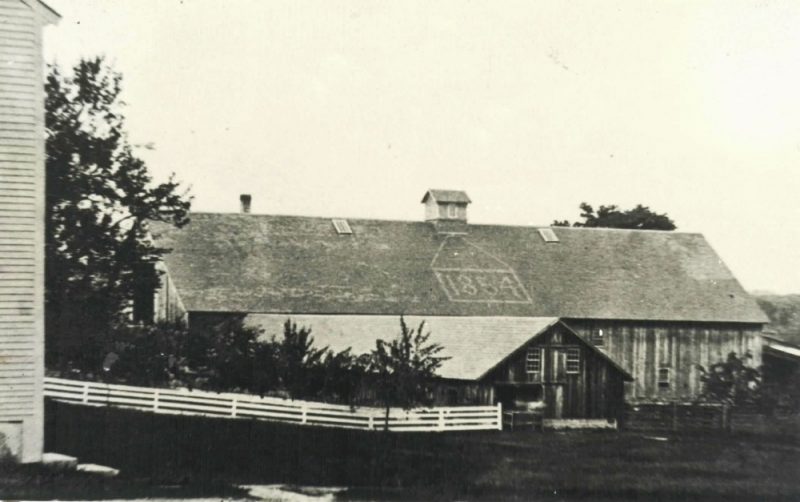
Preservation Wednesday: 1854 Cow Barn Gets a Fresh Coat of Paint
June 10, 2020
Painter Ken Morin has just finished giving the south side of the 1854 Cow Barn a much-needed fresh coat of paint. At 140 feet in length, this project was a considerable undertaking, even before considering that Ken worked through the recent heat wave with temperatures reaching 93 degrees. The barn looks great, congratulations to Ken on a job well done in challenging conditions.
[expander_maker id=”1″ more=”Read more” less=”Read less”]
Enfield Shaker preservation
Enfield Shaker preservation
Enfield Shaker preservation
Enfield Shaker preservation.
[/expander_maker]
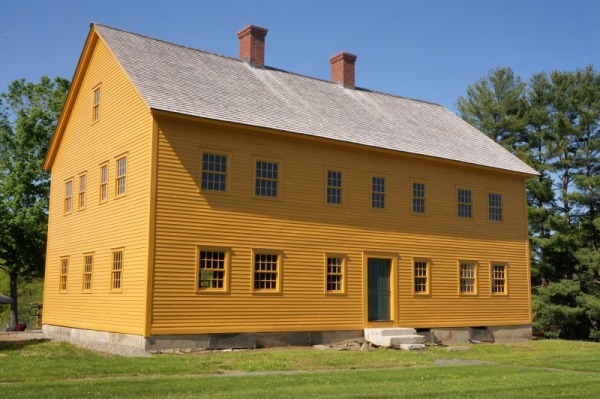
Preservation Wednesday: Brethren’s East Shop Interior Pine Paneling Arrives
May 27, 2020
Today Joel Currier of Currier Farms in Danville, VT delivered some incredible pine paneling for use in the Brethren’s East Shop interior. Joel cuts all this pine from his family property, kiln dries it, and mills it using custom made cutters designed to exactly match the bead of original boards found in the building.
[expander_maker id=”1″ more=”Read more” less=”Read less”]The boards range from eight to sixteen feet in length and are up to 20” wide. The first-floor walls will be sheathed with this pine from floor to ceiling, the second-floor from the floor to three inches above the windowsills, with lath and plaster above.
An original piece of wall sheathing found in the building indicated that it was not tongue and groove, as is sometimes seen, but rather both boards are grooved and they are installed with a separate spline inserted into the grooves. Joel also provided bundles of splines to be used when the boards are installed.
The exterior transformation of this building, with its bold color, has made a huge impact on the site, it will be exciting to see the interior begin to be transformed with the installation of this beautiful pine soon.
Enfield Shaker preservation.
Enfield Shaker preservation.
Enfield Shaker preservation.
Enfield Shaker preservation.
Enfield Shaker preservation
[/expander_maker]
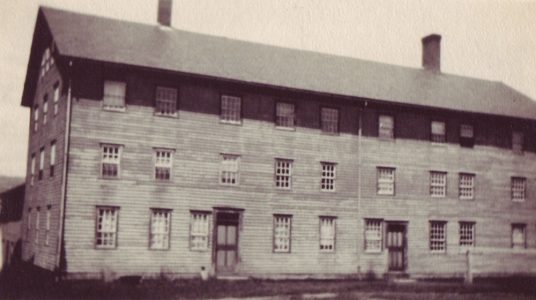
Preservation Wednesday: Laundry Attic and 3rd Floor Curatorial Storage
May 20, 2020
This week we have a look at some projects going on in the 1813/1833 Laundry Building. Two large rooms on the third floor which are used for curatorial storage have been the subject of much effort over the last year. Post-Shaker partitions and wooden shelving have been removed, and 30 three-foot long units of metal shelving donated by Shaker Workshops have been installed, yielding over 450 linear feet of 18” deep shelving. Museum volunteer, Lynn Waehler, is pictured below removing old labels from the shelving.
[expander_maker id=”1″ more=”Read more” less=”Read less”]The arrival of this shelving is timely, as we will eventually have about 120 boxes of archaeological dig artifacts to organize and shelve. Artifacts which have been cleaned, cataloged, bagged, and boxed by students at the Plymouth State University archaeology lab are shown organized by dig year and site, awaiting their final home on the new shelving. Pictured are Lynn and Dick Dabrowski in the process of moving the boxes onto the shelves.
Enfield Shaker preservation.
Enfield Shaker preservation.
Enfield Shaker preservation and collection.
Lynn’s husband, Paul Waehler, works in the attic above, removing post-Shaker boards along the edge of the attic floor. The attic originally had knee walls, located approximately where Paul’s right hand rests on the floor in the photo, and the original Shaker sub-floor and floor ended just outside the now-missing knee walls. Interestingly, the area behind the walls was open to the room below.
Enfield Shaker preservation.
Enfield Shaker preservaton.
Enfield Shaker Preservation.
[/expander_maker]
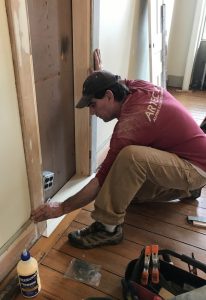
Preservation Wednesday: Meeting Room Cupboard Door Project
May 13, 2020
Work is nearing completion on the Great Stone Dwelling’s Dining Room, so today let’s turn our attention to another important space – the second floor Meeting Room. As with other second-generation Shaker dwelling houses, the Great Stone Dwelling incorporated many design improvements and new technologies to improve comfort, efficiency, and harmony in the inhabitant’s communal life together.
[expander_maker id=”1″ more=”Read more” less=”Read less”]One new feature of this, and other, second-generation dwelling houses was the incorporation of worship space within the house. The Meeting Room provided over 2000 square feet of unobstructed floor space to accommodate the charismatic worship practiced by the Shakers at that time, and is a focal point of the design of the building
The north and south exterior walls each have 6 windows providing abundant light and architectural interest with their shutters and paneling below. The east and west walls, in comparison, are plainer, with central doors leading from both the Brother’s add Sister’s hallways. The broad expanses of wall on either side of these doors contains the ubiquitous peg rail and are punctuated only by small cupboard doors, one in each quadrant of the room.
These cupboards have been the focus of considerable effort this week. Two of the four cupboard doors were in place, but two doors had been removed many years ago. Fortunately, the museum was able to purchase these doors to return them to the site, and Tim Baker is in the process of re-installing them.
As for some of the Dining Room projects described earlier, the removal of post-Shaker trim has revealed details which have increased our knowledge of the design of these cupboards. The cupboards utilized the space between the room and the adjacent Shaker chimneys. The 20th Century removal of the chimneys disturbed the backs of the cupboards to differing degrees, but much evidence of their design remains. It appears that the two north cupboards had shelves, possibly for hymnals, while the two south cupboards did not.
So far this week, Tim has been able to repair and return a span of peg rail to its original location, replace missing peg rail with reproduction stock, repair original door trim, and recreate the door casing/cupboard sides and threshold in one of the openings. Some interesting joinery has been discovered and will be the model for work on the remaining three openings.
Because of their location along a vast expanse of wall, these simple cupboards create a powerful focal point and are an important part of the visual impact of the room. Tim’s work in returning them to their original appearance will again remind us how small details and features, working together as part of a whole, create the unique Shaker interiors that we cannot help to marvel at, no matter how often we see them.
Like a good season finale, I will leave you with a teaser: Stay tuned to see what Tim discovered adjacent to one of these cupboards as part of his investigation. Coming to a Preservation Wednesday soon.
Enfield Shaker preservation
Enfield Shaker preservation
Enfield Shaker preservation.
Enfield Shaker preservation
[/expander_maker]
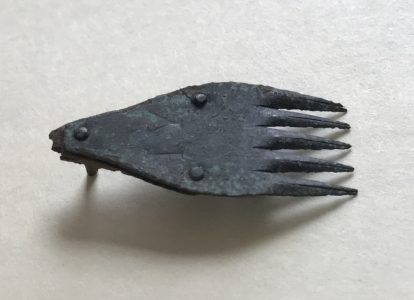
Isaac Newton Youngs Rastrum Pen Nib
May 7, 2020
The Museum’s Archaeological Field School in conjunction with Plymouth State University under the supervision of Dr. David Starbuck dug within the foundation of the former Boy’s Shop in 2018. Located north of the East and West Brethren’s Shops, it can be seen in this photo taken from the cupola of the Great Stone Dwelling, indicated by the red arrow.
The foundation hole contained a rich collections of artifacts, with some areas seeming to be more artifacts than dirt at times. Mixed in with this vast array of found items is a small brass tool that is on of the most exciting finds in our 5 years of digging. [expander_maker id=”1″ more=”Read more” less=”Read less”]
It is part of a rostrum used in inking 5 parallel lines on paper for a music staff. This pen nib is about an inch long and half-inch wide, with remains of wood that formed the handle. There are 5 “tines” which are bent lengthwise into a shallow “v” and split up the center. On the back are the initials “I.Y.” which stand for Isaac Newton Youngs, a Shaker at the Watervliet Shaker Village who made these pens.
Music was very important to the spiritual and social lives of the Shakers, and they were prolific song writers. Much effort was spent teaching music in the communities and sharing music between villages. This pen nib, likely made ca 1840 shows some of the effort expended fostering music in the villages – a product manufactured in one village, distributed to another village, in order to record music for use within the family as well as communication of songs between villages. A great story illustrated by a unique and fascinating artifact. Many thanks to the diggers at the 2018 Field School, and especially Brenden LaFleur who discovered this item.
The start of the museum’s 2020 Field School in conjunction with Plymouth State University has been postponed until June 1, 2020. For more information about archaeology at the Enfield Shaker Museum or updates on the scheduling of this dig, contact education@shakermuseum.org.
Enfield Shaker collection
Enfield Shaker preservation
Enfield Shaker preservation
Enfield Shaker collection
[/expander_maker]
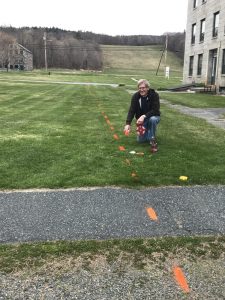
Preservation Wednesday: Laying out the Great Stone Dwelling Orchard
May 6, 2020
In addition to the restoration work on our buildings, we are also continually working on the grounds with an eye to restoring as many of the 19th Century Shaker features and layout as possible. Towards that end, Museum Herbalist Diana Kimball-Anderson is in the process of planning an orchard for the south lawn of the Great Stone Dwelling, based on photos of the original Shaker orchard there. Today museum board member and preservation volunteer Paul Waehler began to layout the lines for the planting of the trees. [expander_maker id=”1″ more=”Read more” less=”Read less”]
Paul scrutinizes historic photos and maps to plot the locations of the rows and each individual tree within each row. Paul has honed these skills over the past few years preparing for our archaeological digs, he plots the corners of the buildings to guide us in locating our dig pits and is usually within a couple of inches of the actual foundation corners discovered during the digs. We look forward to seeing this project progress through the coming months.
Enfield Shaker preservation.
Enfield Shaker preservation.
Enfield Shaker preservation.
[/expander_maker]
Hands-on Circular Knitting Machine: A short video
April 30, 2020
Enjoy this quick YouTube video showing the hands-on circular knitting machine in Exhibit Room 2 of the Great Stone Dwelling.
Quote of the Day: A Spring Message from the May 1897 Manifesto
April 29, 2020
With our recent late-April snowfall, a spring quote seems especially welcome. This quote is from the May 1897 edition of The Manifesto, published monthly by the Shakers. The Home Notes section relayed news from each community, and this quote is from Enfield’s entry. [expander_maker id=”1″ more=”Read more” less=”Read less”]
“We hail with joy the pleasant chirpings of the robin redbreast as his cheery song floats out upon the morning air. Altho the cold season has not been unusually severe and general health has prevailed in our Society, still we are ready to sing, – “Winter, adieu, your time is through.” ”
Photo credit:
Photo credit: Read up on our NH Robins @ https://nhpbs.org/wild/americanrobin.asp
[/expander_maker]
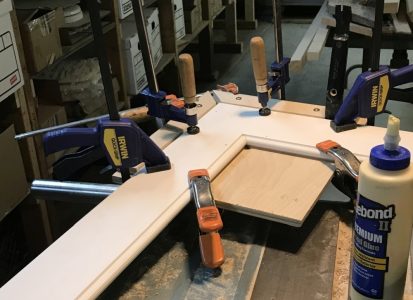
Preservation Wednesday: Dining Room Doorway Trim Restoration
April 29, 2020
With the restoration of the west wall of the Great Stone Dwelling Dining Room almost complete, we could not stop without addressing the door trim on the hall side, could we? Of course not! [expander_maker id=”1″ more=”Read more” less=”Read less”]
The original Shaker trim had been cut away in the mid-20th Century and broad, thick replacement trim had been installed to allow the door orientation to be changed. This week Tim Baker removed the post-Shaker trim and is making reproduction Shaker trim to restore the opening. Shout out to Doug Henson at Pitch Pocket Woodworks of Haverhill, NH, who ran the stock for this project and hit the Shaker profile spot on.
Tim found that because the non-Shaker trim was so wide, the peg rail had been cut and would now not extend to the reproduction door trim he was about to install. Because this is a piece of original peg rail in its original location (confirmed by nail holes behind it) we make every effort to conserve as much of it as possible. Tim joins a piece of new peg rail to the original to make it long enough to be coped (cut to match) to the reproduction door trim.
The baseboard was not original either, so Tim is making and installing new baseboard. Note how the baseboard sits into a groove that runs all around the perimeter of the flooring. Tim’s attention to these details will make this new door trim the perfect complement to the ongoing beautiful restoration in the Dining Room this winter.
Enfield Shaker Preservation
Enfield Shaker preservation
Enfield Shaker Preservation
Update: The new trim and restored original peg rail has been installed. Here is a look at the original peg rail with the added piece coped to the door trim. Museum volunteer Dick Dabrowski prepares the newly installed woodwork for painting.
Enfield Shaker preservation
Enfield Shaker preservation
Enfield Shaker preservation
[/expander_maker]
Tuesday Tour: The Granite of the Great Stone Dwelling
April 28, 2020
This YouTube video (2:27) examines the granite of the Great Stone Dwelling.

Great Stone Dwelling Dining Room Table
April 23, 2020
In January of 2019 the Enfield Shaker Museum received a donation that funded the purchase of one of the original Enfield dining room tables at auction at Southeby’s in New York City. It is very exciting to have this unique artifact, one of only three remaining Enfield dining tables, returned to the room where it was designed and made to be used in 1841.
[expander_maker id=”1″ more=”Read more” less=”Read less”]The table is yellow birch, the most common furniture hardwood at Enfield, and is a remarkable 21’ 6” long. The top is made of two yellow birch boards each the length of the table, one 15.5 inches wide the other 19.5 inches wide, joined with a spline joint.
The top is supported by a center trestle and three legs with graceful, high arched bases. Having only three sets of legs over this long span results in a surprisingly delicate, graceful, and ethereal look when viewed from the side.
The table is exhibited in the dining room with place settings that replicate those seen in photographs taken in the 1870’s and 1880’s, supported by information from artifacts of ironstone discovered in several of our archaeological field schools in conjunction with Plymouth State University.
This table was central to daily life of the Enfield Church Family Shakers who dined at it three meals a day for over 8 decades. Its arrival, along with the ongoing restoration of the dining room, helps us convey the sense of what that daily life looked and felt like in the 19th Century Shaker village.
( Click here to read an article from our monthly newsletter chronicling this tables 96 year journey from its sale by the Shakers in 1923 to its return to the Dining Room in 2019)
Enfield Shaker collection
Enfield Shaker collection
Enfield Shaker collection
[/expander_maker]
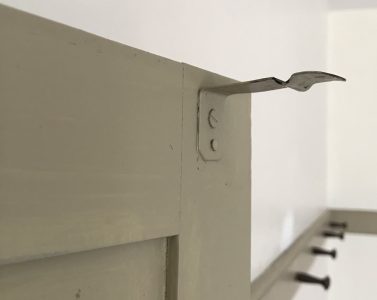
Preservation Wednesday: Great Stone Dwelling Cupboard Catches
April 22, 2020
Restoration of built-ins in the Great Stone Dwelling has been ongoing the last few years. Visitors enjoy seeing our woodworkers working to restore the unique features of the building, repairing original components, and recreating missing features where necessary. But in addition to all the woodwork there are hardware issues to consider as well.
[expander_maker id=”1″ more=”Read more” less=”Read less”]Today we were excited to get our first look at reproduction cupboard door catches that have just been custom made for us. Each cupboard door has a spring steel catch that engages with a brass tack affixed to the bottom of a shelf in the cupboard to hold the cupboard door firmly closed. While many of these catches are still in place and operable, a number are missing, and an exact replacement is not available commercially.
Museum volunteer, Dick Dabrowski, who is overseeing our restoration projects, set about to find a New Hampshire manufacturer who could reproduce these for us. He interviewed several fabricators who were quite frankly too large to tool up for a project of this size, but found a Hooksett, NH fabricator named Ranall Metal Technology, Inc. who was willing to take on the project.
Dick provided them an original catch as a sample, and they have just delivered us 300 catches which are so accurate that it appears that we will be able to use original holes where available to mount the catches. These should keep us supplied with spring steel catches for cupboard doors for the foreseeable future.
[/expander_maker]
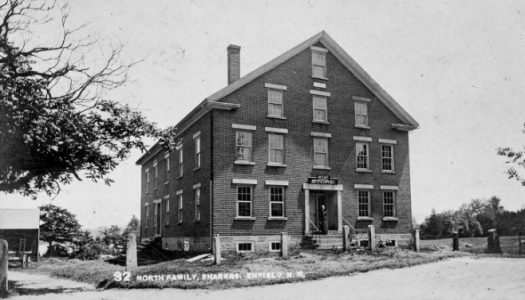
This Week in Shaker History: The North Family Fast Day Fire of 1856
April 16, 2020
The North Family was Enfield’s Gathering Order where new members would live while trying out Shakerism. It is located just to the north of the Church Family, where the La Salette Shrine is located today. On Fast Day, April 10, 1856, a calamitous fire broke out as described by former Shaker Henry Cumings in an article entitled “Sketch of the North Family of Shakers”, published in the Enfield Advocate on May 16, 1913:
[expander_maker id=”1″ more=”Read more” less=”Read less”]“April 10, 1856, being Fast day, occurred the great fire that swept away about a dozen buildings in all. The fire started in the mill, which stood where the pail shop was afterwards erected, and there being a strong wind from the north the fire was quickly swept through a row of barns, sheds and other buildings, most of them old and not very valuable but three of them were better. It seemed for a time as though it would sweep the entire group. By the most strenuous effort the long wood shed and the Stone house and the front row of buildings were saved. A new mill was erected the same year. This building was afterwards made into a tub and pail factory in 1869, and was used for that purpose til 1892, I think, when the pail machinery, engine, etc., were sold, and about a year later it took fire and burnt down.”
In this postcard image, the North Family buildings that survived the fire are seen in the center left, with the Church Family beyond and even the Second Family in the distance to the right. The dozen buildings that were lost in the fire would have been to the left (north) of the buildings seen in this photo.
In this view of the lake taken from the hill by Col. Frank C. Churchill in the late 19th Century, the buildings in the lower right are the buildings that were built to replace the burned ones. No photographs are known to exist of the North Family before the fire.
[/expander_maker]
Preservation Wednesday: Dining Room Restoration and Installation of the Atkins Clock Company Wall Clock
April 8, 2020
This YouTube video (1:26) looks at some of the recent restoration work in the Dining Room of the Great Stone Dwelling and the installation of the Atkins Clock Company wall clock.


